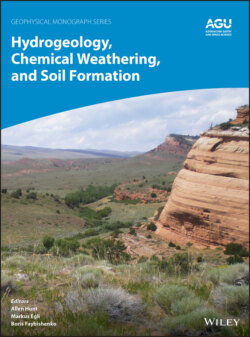Читать книгу Hydrogeology, Chemical Weathering, and Soil Formation - Allen Hunt - Страница 27
1.4.3. Soil Landscapes
ОглавлениеSoil catenas are two‐dimensional transects along hillslopes. They form part of a geomorphic system, the flows of material and energy within which are characteristically three‐dimensional. In moving down slopes, weathering products tend to move at right angles to land‐surface contours. Flowlines of material converge and diverge according to the curvature of contours. The pattern of vergency influences the amounts of water, solutes, colloids, and clastic sediments held in store at different landscape positions. Of course, the movement of weathering products alters the topography, which in turn influences the movement of the weathering products; there is feedback between the two systems.
As soil evolution takes place within a three‐dimensional mantle of material, the spatial pattern of many soil properties will reflect the three‐dimensional topography of the land surface. Indeed, according to the concept of soil‐landscape systems, the dispersion of all the debris of weathering, solids, colloids, and solutes, is, in a general and basic way, influenced hugely by land surface (and phreatic surface) form and organized in three dimensions within the framework imposed by the drainage network (Huggett, 1975).
Investigating the effect of landscape setting on pedogenesis requires a characterization of topography in three dimensions. Early attempts to describe the three‐dimensional character of topography was made by Andrew R. Aandahl (1948) and Frederick Troeh (1964). Later, geographers and geomorphologists explored methods of terrain description (e.g. Moore et al., 1991). Topographic attributes that appear to be important are those that apply to a two‐dimensional catena (elevation, slope, gradient, slope curvature, and slope length), plus those pertaining to three‐dimensional landform (slope direction, contour curvature, and specific catchment area).
In distilling previous work on digital soil models, Alex McBratney and his colleagues (2003) proposed that soil is a function of seven factors (the so‐called SCORPAN factors), as follows:
where S is soil (Sc for soil classes or Sa for soil attributes or properties) at a point; s is existing soil information; c represents climate; o represents organisms or biological activity; r represents topographic or landscape attributes; p represents parent material; a represents age; n represents spatial position. Nathan Odgers et al. (2008) emphasized the strong influence of topography on soil characteristics and soil formation processes, noting that such topographic variables (terrain parameters, topographic attributes) as slope, landscape curvature, and flow direction are readily derived from a digital elevation model. They demonstrated how toposequences can be generated from such models.
Three‐dimensional topographic influences on soil properties were considered in small drainage basins by the present author (Huggett, 1973, 1975) and Willem J. Vreeken (1973), while André G. Roy and his colleagues (1980) considered soil–slope relationships within a drainage basin. Later work has confirmed that a three‐dimensional topographic influence does exist, and that some soil properties are very sensitive to minor variations in the topographic field (e.g. Moore et al., 1991, 1993; Fissore et al., 2017; Li et al., 2018; Iticha & Takele, 2018).
